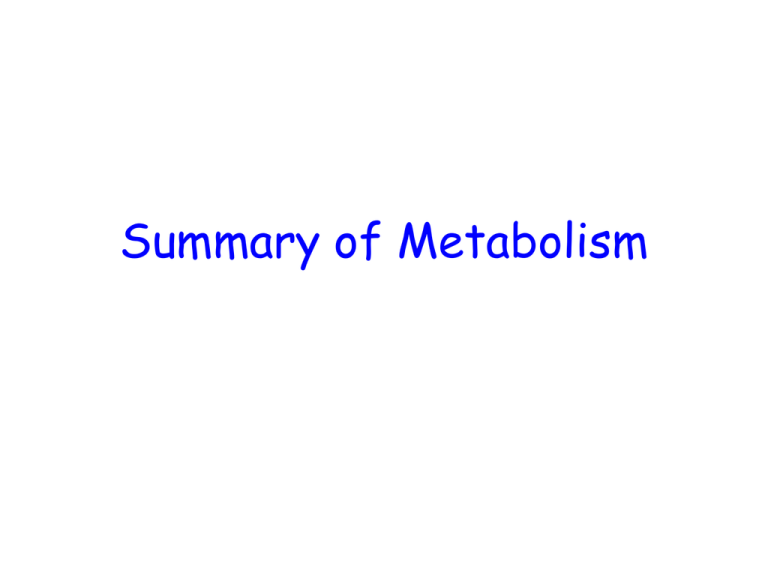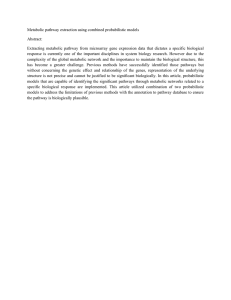Summary of Metabolism
advertisement

Summary of Metabolism Basic Strategies of Catabolic Metabolism • Generate ATP • Generate reducing power • Generate building blocks for biosynthesis ATP • Universal currency of energy • High phosphoryl-transfer potential • ATP hydrolysis drives reactions by changing the equilibrium of coupled reactions by a factor of 108 • Generated from the oxidation of fuel molecules Reducing Power • Oxidation of fuel molecules generates NADH for mitochondrial ETC • NADPH is generated for reducing power for biosynthetic processes • Pentose phosphate pathway is the major source of NADPH Biomolecules • Large number of diverse macromolecules are synthesized from a small number of building blocks. • Carbon skeletons from generated from the oxidation of macromolecules provide the building blocks for biosynthetic pathways. • Central metabolic pathways have anabolic as well as catabolic roles. Relationships between catabolic and anabolic processes • The pathway leading to the biosynthesis of a compound are distinct from the pathway leading to its breakdown • This separation ensure that the processes are thermodynamically favorable in both directions • Allows for reciprocal regulation Themes in Metabolic Regulation • Allosteric regulation • Covalent modification • Control of enzyme levels • Compartmentalization • Metabolic specialization of organs Allosteric regulation • Typically associated with enzymes that catalyze irreversible reactions • Allosteric regulators can cause feed back or feedforward regualtion • Allosteric regulators are often related to the energy state of the cell • This type of regulation allows for immediate response to changes in metabolic flux (milliseconds to seconds) • Functions at local level Covalent Modification • Covalent modification of last step in signal transduction pathway • Allows pathway to be rapidly up or down regulated by small amounts of triggering signal (HORMONES) • Last longer than do allosteric regulation (seconds to minutes) • Functions at whole body level Enzyme Levels • Amount of enzyme determines rates of activity • Regulation occurs at the level of gene expression • Transcription, translation • mRNA turnover, protein turnover • Can also occur in response to hormones • Longer term type of regulation Compartmentalization •One way to allow reciprocal regulation of catabolic and anabolic processes Specialization of Organs • Regulation in higher eukaryotes • Organs have different metabolic roles i.e. Liver = gluconeogenesis, Muscle = glycolysis • Metabolic specialization is the result of differential gene expression Lots ATP G-6-P Low ATP Need skeltons Starvation • Fuels change from glucose to fatty acids to ketone bodies

